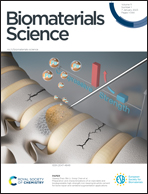Injectable composite hydrogels encapsulating gelatin methacryloyl/chitosan microspheres as ARPE-19 cell transplantation carriers
Abstract
Retinal pigment epithelial (RPE) cell transplantation is being explored as a feasible approach for treating age-related macular degeneration. The low aggregation ability of RPE cell suspensions or microtissues after transplantation has limited cell utilisation. Therefore, alternative transplantation strategies should be explored to induce cell aggregation and maintain cell viability. Herein, we propose a composite hydrogel that encapsulates gelatin methacryloyl (GelMA)/chitosan microspheres (GCMSs) as ARPE-19 cell transplantation carriers. The diameter of the GCMS was adjusted by tuning the parameters of the microfluidic devices, yielding a cell-adhering platform that induced uniform cell spreading. The live/dead assay and immunofluorescence results showed that ARPE-19 cells adhered and spread uniformly around the microspheres. Moreover, the hydrogel sheets were used to provide an aggregated protective shell, and the ARPE-19 cells on the microspheres encapsulated within these hydrogel sheets remained viable post-injection and produced fewer reactive oxygen species after cyclic stretching. Furthermore, we found that the composite hydrogel was biodegradable and biocompatible in vivo. Therefore, GCMSs provide an injectable microcarrier for ARPE-19 cells, and the hydrogel provides an aggregated protective shell in this novel platform, which has considerable potential for an alternative injectable and highly aggregated RPE cell transplantation strategy design.



 Please wait while we load your content...
Please wait while we load your content...